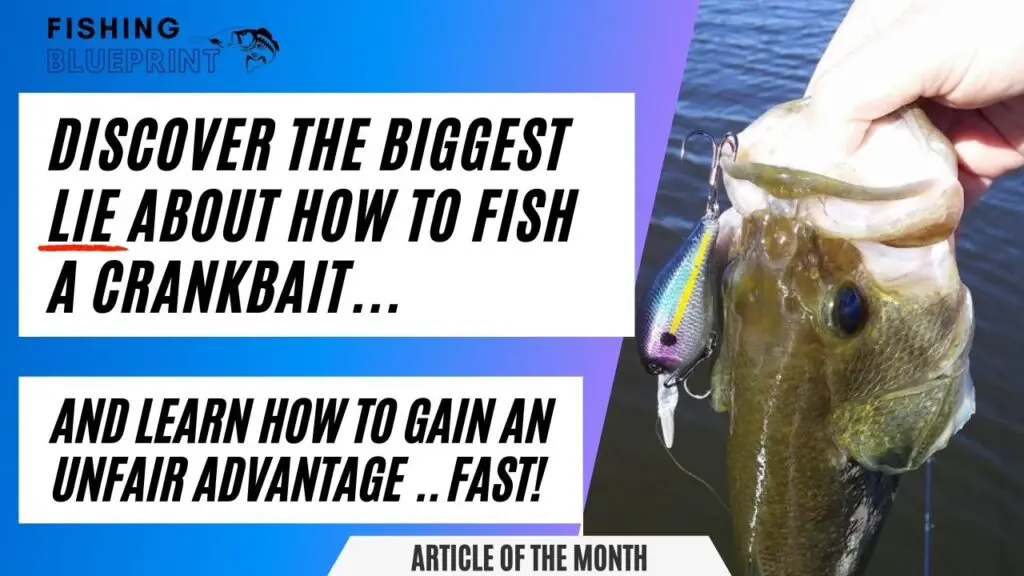Apache Lake Fishing
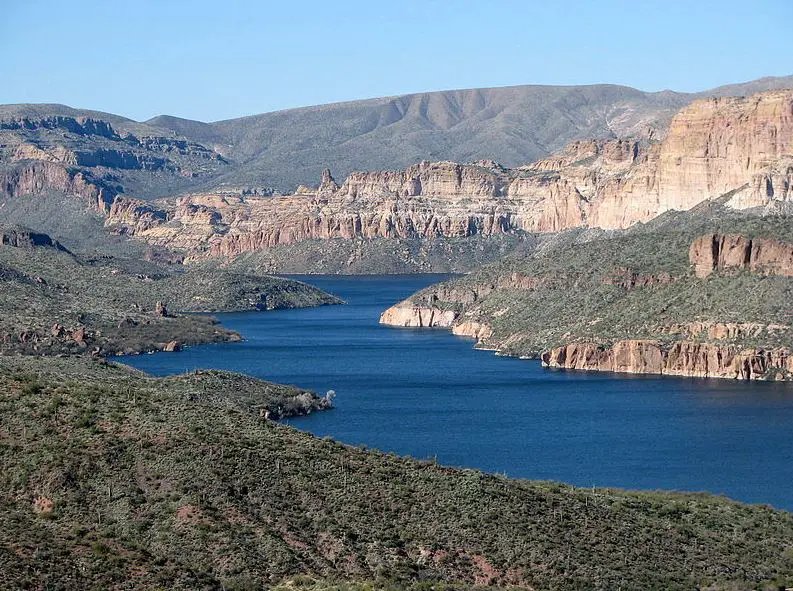
Apache Lake is a moderate sized desert reservoir that is located 43 miles away from Phoenix, Arizona. Overall it’s a relatively popular lake being nestled in part of the central section of the state. In this post you’re going to be given the blueprint to fish this lake.
So what are the best tips for fishing Apache Lake? There are three important factors you must know if you want to know how to fish Apache Lake successfully. First, you need to know what kind of fish is in Apache Lake. Second, it’s important for you to know which part of the lake each species can be found. Lastly, knowing what are the best baits that work on Apache Lake is vital. However, tactics, baits, and locations will be different for each type of fish that you target. So let’s talk about the steps you need to take in order to give you the best chance of catching a fish on Apache Lake.
Key Takeaways
This lake gives locals and visitors the opportunity to test their luck in catching one of the many game species this lake has to offer, such as Largemouth Bass, Smallmouth Bass, Yellow Bass, Channel Catfish, Bluegill, and much, much more!
Here’s the most recent and updated Apache Lake Fishing Report – it gives you a quick and easy list of some really good fishing spots. If you’re looking for more detail on how to fish each spot scroll down into the article.
- Burnt Rock Cove
- Alder Creek & Amethyst Cove
- Sam’s Straight
- Cross Point
- Haystack Point & Haystack Straight
- Shoreline between Saguaro Point to Horsetail Bay
- Bar Point (Bluff Walls)
- Mazatzal Cove
- Small coves between Gila Bay to Chukar Wash
- West walls of Horse Flat
- Bluff walls along the Buckhorn Creek area
Here are some additional fast and helpful tips just for you:
- The easiest way to fish this lake is by boat, but there are areas to fish from the bank, by kayak, or float tube.
- There are multiple public boat ramps to use.
- Camping and RV parking is available.
- You can buy tackle and groceries at the lake or at one of the tackle shops in Phoenix.
- A permit is required to enter, camp, and fish this lake. Prices vary depending on your desired activity.
About Apache Lake
Located just outside of east Phoenix, Apache Lake is a deep body of water with the average depth being 235 feet and a maximum depth of 266 feet when the lake is completely full. Being 17 miles long and spans over 2,660 acres. This is a reservoir within the Salt River chain lakes and plays a vital role in power generation agriculture.
Anglers can fish a variety of locations from grass mats, river channel drops-offs, rock piles, cuts and points. Known for its great largemouth bass, yellow bass, and catfishing. You can also see wildlife such as bald eagles and bighorn sheep.
Personally, this is one of my favorite places to fish.
My personal fishing report update:
Alright, my fishing friends, let’s dive into the current scene on the water.
Lately, the wind’s been tossing us a curveball, making our quest for that trophy a bit more of an adventure.
But, as any savvy angler knows, those breezy conditions can’t keep a good fisherman down. In fact, some folks are absolutely slaying it with largemouth and striped bass during those calm windows between weather fronts.
So, here’s the lowdown: those northern coves are still where the party’s at, although our bass buddies are doing a bit of a dance—moving in and out depending on whether they’re cozying up on their beds.
Some anglers have been hitting the shallows, about 4 feet deep, with a trusty drop shot setup and have been hooking into some beauties. Then, shifting gears and going deeper, they bagged a chunky 6-pounder. Tallying up, they netted themselves 15 to 20 largemouths, most tipping the scales between 1 and 2.5 pounds.
And get this, the bass are in full-on love mode in the shallows at the back of the coves, while the post-spawn crowd is hanging out off the points, islands, and reefs. The numbers might not be blockbuster yet, but patience is key.
Helpful tip: anything white will be like bass candy right now— jerkbaits, crankbaits, you name it.
For the lure lovers here’s a list of what is working right now:
- Topwaters
- Swimbaits
- Umbrella rigs
- Jerkbaits
- Football jigs
- Crankbaits
- Drop shot
- Texas rig worm or creature baits
- Carolina rig
Guys, the northern hideouts where the bass are busy spawning and can be easily caught.
I got talking to a guy loading his kayak who fished from mid-morning to afternoon and landed two largemouths on drop shots.
So there you have it, my angling amigos…
The fish are out there, dancing with the elements, and it’s up to us to join the party. Keep those lines tight and your spirits high, and remember, every day on the water is a good day.
What Kinds Of Fish Are In Apache Lake
- Largemouth Bass
- Smallmouth Bass
- Rainbow Trout
- Yellow Bass
- Black Crappie
- Walleye
- Carp
- Bigmouth Buffalo Fish
- Channel Catfish
- Flathead Catfish
- Bluegill
- Green Sunfish
- Redear Sunfish
- Tilapia
Special Closures Areas or Dates:
Periodic closures due to wildfires. Check the status of the lake to see if it’s open, click here.
Special /Annual Events:
Weekend fishing tournaments are common.
Apache Marina offers food, bar, live music, karaoke, and annual watch parties for all the big sporting events and tournaments (ie; March Madness, Superbowl, World Series), and much, much more.
Apache Lake Fishing Tips & General Strategies

photo: AZGFD
General Tips Before You Fish The Apache Lake...
Of all the Salt River chain reservoirs, Apache Lake has to be considered the best smallmouth bass fishery.
A few years back a massive golden algae bloom decimated the smallmouth population. However, they steadily returned. Some say the smallies are even stronger than ever!
Apache lake provides anglers with ample rocky structure that one would normally find on this type of canyon reservoir.
This lake I feel is the most windy when compared to Saguaro, Canyon, or Roosevelt.
Of all the Salt River chain reservoirs, Apache Lake has to be considered the best smallmouth bass fishery.
General Structure
Apache Lake has an ample supply of points, walls, cuts, inner and outer channel bends, humps, ledges, as well as natural and artificial structure.
During the early part of the year (late winter/early spring) bass will be approximately 20-40-feet deep, and will be found next to flats with deep water near by.
During spawn you’ll have the best luck inspecting the south facing banks with good sun exposure in 1-10-feet of water.
As the weather heats up, you’ll most likely find bass on any north-facing bank that offers shade, or provides a break from the current.
Water Clarity
Apache Lake is mostly a light-moderate stained lake.
Natural colors to well here, along with some colors hints, of chartreuse, orange, and red.
Good ol’ black and blue also are awesome in the early mornings and evenings.
But Where Exactly Are The Best Places To Fish At Apache Lake?
Starting from the west end of the lake moving to the east, here is that list of the best fishing spots at Apache Lake.
DISCLAIMER: The material provided is for general information purposes only. It’s important to understand that any information provided in this article can change at any time. Any maps or graphics featured are not to be used as navigational aids. Fishing Blueprint will not be responsible for any personal injury or property damage from any misuse of the maps or graphics provided. It’s completely impossible to give you every single spot where you can potentially catch a fish. But, what this list does do is to give you a helping hand and narrow down to the most productive fishing spots.
Burnt Rock Cove
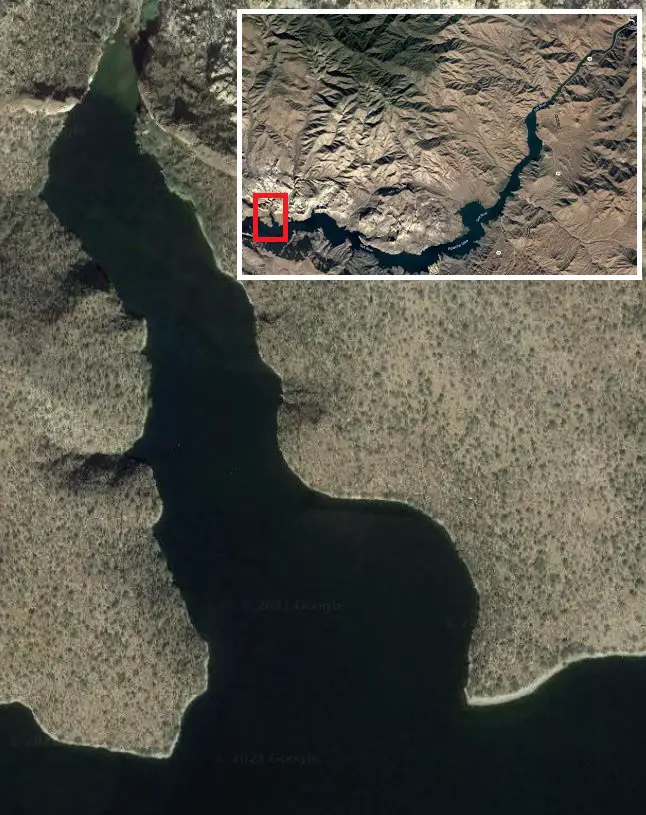
This cove is one of the largest coves that Apache has to offer.
It’s nearly 700 yards long (or roughly the length of 7 football fields) and is very rocky with steep banks.
Burnt Rock Cove also has a deep channel running through it.
This cove is incredibly popular for bass, crappie, and yellow bass in the spring.
There is a significant channel swing in the middle of this cove so make sure you graph it to check for fish.
There are also several good ledges to fish during the summer.
If the wind is howling on the lake this is a great spot to get some reprieve.
Topwater lures, frogs, swimbaits, and crankbaits work great. Yellow bass will also hold in school at the mouth of the cove.
Crappie will suspend over submerged brush in the middle of the cove.
Scan the intersections for ledges, drop offs, boulders, rock piles, ridges associated with the two intersecting channels.
Effective baits for this area include: topwater lures, flutter spoons, buzzbaits, crankbaits, soft plastic swimbaits, spinnerbaits, chatterbaits, jerkbaits, swim jigs, hair jigs, and underspin jigs when the bass are aggressive.
If the bass are timid, then drop shot, tubes, Ned rig, Neko rig, Mojo rig, Carolina rig and football jigs all work really well.
Located: West end
Structural features: Rocky structure, deep channel, minimal brush, drop-offs, large mid-cove channel swing, points
Best species to target: Bass, yellow bass, crappie, bream, trout
Most effective way to fish this spot: Boat – Trolling with a downrigger, trolling without a downrigger
Alder Creek & Amethyst Cove
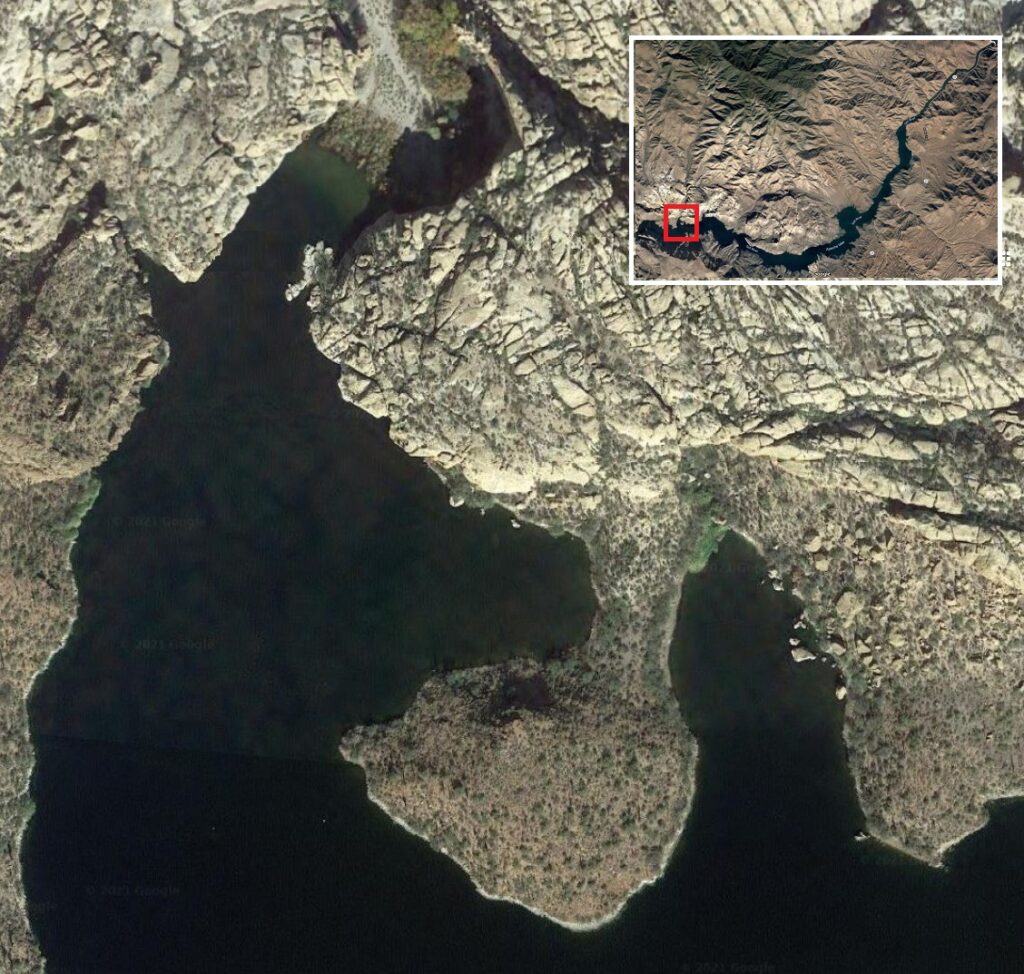
During the summer when the water is high portions of these coves this area turns into a floating vegetation mat where frogs and buzzbaits prevail. These small areas are great to fish after a summer thunderstorm passes through.
These are great coves for bed fishing during the spring spawn.
Crappie will suspend over submerged brush in the middle of the coves.
The river channel will often harbor bass, crappie, yellow bass, and catfish that retreat away from the midday heat can be fished a similar way.
This area can be a big time party cove on summer weekends – FYI.
When there is current flowing it also baitfish and bass will hold near the edges, points, and cuts within the weedbed.
Furthermore, there are several areas on the deep channel ledge that are hard spots more so than the surrounding areas. Bass will also congregate around these spots.
Effective baits for this area include: buzzbaits, crankbaits, chatterbaits, soft plastic swimbaits, spinnerbaits, jerkbaits, swim jigs, hair jigs, and underspin jigs when the bass are aggressive. Flutter spoons work great in the deeper channel sections as well.
If the bass are timid, then drop shot, tubes, Ned rig, Neko rig, Mojo rig, Carolina rig, and football jigs all work really well.
Located: west lake
Structural features: Bluff walls, cuts, natural and artificial submerged structure
Best species to target: Bass, yellow bass, crappie, and catfish
Most effective way to fish this spot: Boat
Sam's Straight
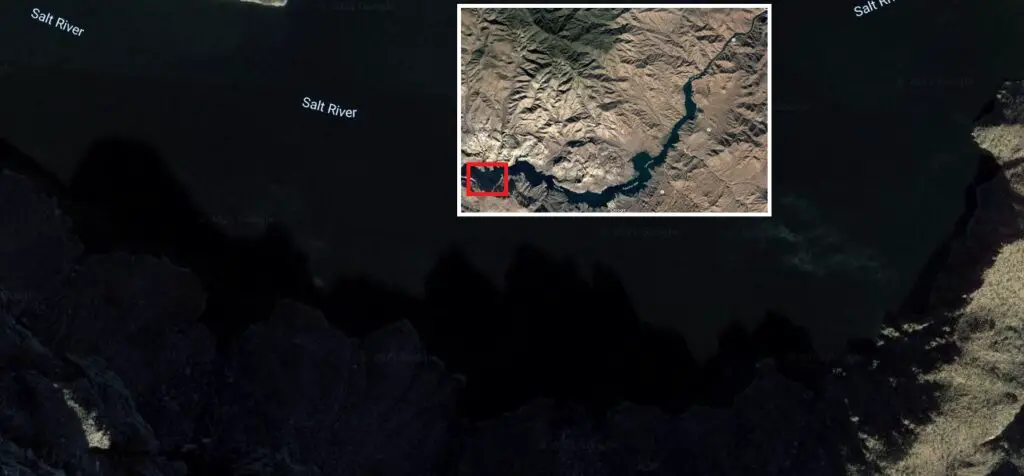
Sam’s Straight is an area where the Salt River channel veers south to makes a u-turn heading north.
This section of lake is across the lake from Alder Creek & Amethyst Cove and to the west of Sam’s Cove.
It can either by absolutely on fire or a ghost town.
Why am I mentioning this area? Because under the right conditions, this area can catch you a boat load of fish in less than an hour.
It’s best fished during calm weather, or when the current is slow.
Make sure you fish the channel swing and 50-yards to the east and west of it.
Effective baits for this area include:
It can be highly productive with topwater lures and buzzbaits.
In the afternoon, crankbaits are great when fished parallel to the shaded shoreline. Jigs should be flipped between gaps and crawled over boulders in the shadow-line.
Other times, fishing soft plastic swimbaits, chatterbaits, underspin jigs, and spinnerbaits are always a good choice for fishing in a rocky area like this when bass are aggressive.
If the bass are timid, then drop shot, tubes, wacky rigged senko, Mojo rig, Texas rig, Ned rig, Neko rig, Mojo rig, Carolina rig, and football jigs all work really well.
Located: west end, south side
Structural features: Rocky structure, minimal brush, drop-offs, points
Best species to target: Bass, yellow bass, crappie, bream, trout
Most effective way to fish this spot: Boat
Cross Point
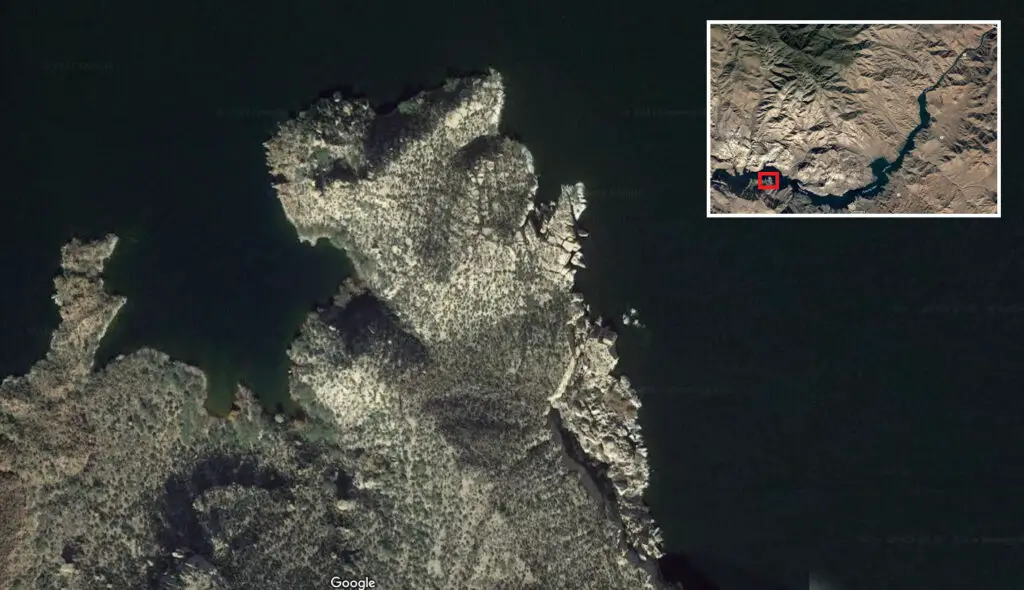
Cross Point is unique because it’s fished differently on each side.
The west side adjacent cove grows a large amount of vegetation
During the summer when the water is high this area turns into a floating vegetation mat where frogs and buzzbaits prevail.
Jigs pitched into gaps or skipped under overhangs can be very effective.
However, as you can see, on the east end has a TON of boulders, cracks, and cuts.
Soft plastic swimbaits, chatterbaits, underspin jigs, and spinnerbaits are great in this area. Football jigs crawled over the boulders or flipped into the shadows can often catch a handful of bass.
Other times, fishing drop shot bait, frog lure, flipping lure, heavy vegetation punching bait, or a Texas rigged Senko. over submerged grass can often draw out monster bass.
Located: west lake, south side.
Structural features: Vegetation, boulders, point, north facing, afternoon shadow lines.
Best species to target: Bass, yellow bass, crappie, and catfish
Most effective way to fish this spot: Boat.
Haystack Point & Haystack Straight
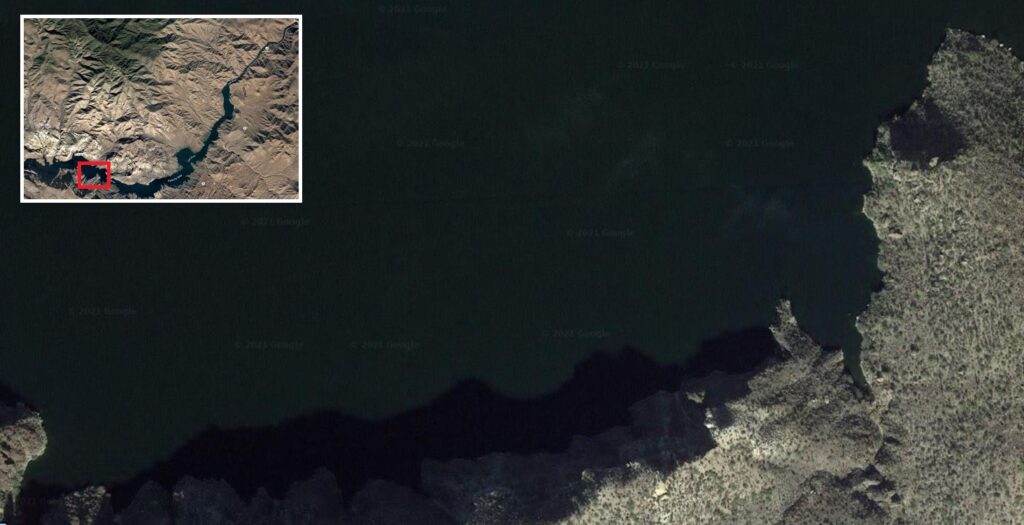
This section of the lake if good due to several factors, such as:
- North facing shadow lines
- A variety of submerged structure
- Main lake channel swing
- Nearby cove next to deep water
Similar to Sam’s Straight, Haystack Straight is an area where the Salt River channel veers south and makes a sharp 90-degree turn to the west.
The cove next to Haystack Points can be a great cove during the spring spawn and is often overlooked.
You’ll see a large quantity of boulders, cracks, and cuts.
Soft plastic swimbaits, chatterbaits, underspin jigs, and spinnerbaits are great in this area. Football jigs crawled over the boulders or flipped into the shadows can often catch a handful of bass.
Other times, fishing drop shot bait, frog lure, flipping lure, heavy vegetation punching bait, or a Texas rigged Senko. over submerged grass can often draw out monster bass.
The river channel will often harbor bass, crappie, yellow bass, and catfish that retreat away from the midday heat can be fished in a similar way.
Located: west end, south side
Structural features: Rocky structure, minimal brush, drop-offs, points
Best species to target: Bass, yellow bass, crappie, bream
Most effective way to fish this spot: Boat
Shoreline between Saguaro Point to Horsetail Bay

As you can see in the photo above, this section of north facing shoreline that extends from Saguaro Point to Needles Cove and it spans nearly a full mile of fish catching possibilities.
This shoreline is filled with a ton of cuts, washes, boulders, pockets and feeder cuts.
Some areas will have heavy brush that often holds giant bass.
Additionally, you’ll find a submerged roadbed on the graph, fish the outside edge to target both largemouth and smallmouth bass.
Soft plastic swimbaits, chatterbaits, underspin jigs, and spinnerbaits are great in this area. Football jigs crawled over the boulders or flipped into the shadows can often catch a handful of bass.
Other times, fishing drop shot bait, frog lure, flipping lure, heavy vegetation punching bait, or a Texas rigged Senko. over submerged grass can often draw out monster bass.
Located: west end, south side
Structural features: Rocky structure, submerged brush, drop-offs, points
Best species to target: Bass, yellow bass, crappie, bream
Most effective way to fish this spot: Boat
Bar Point (Bluff Walls)
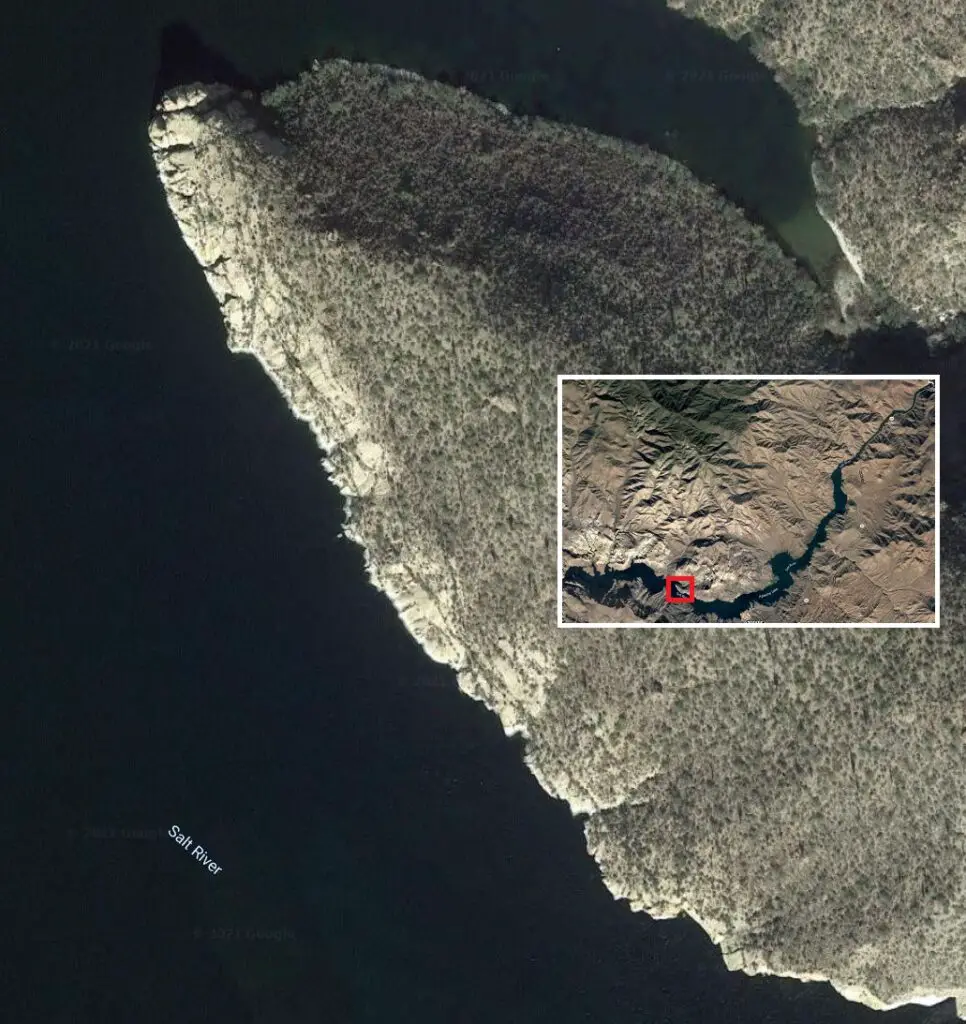
This spot is a bluff wall where the river channel swings into a bluff wall and it can be fished year round.
The bass will commonly hold close to the large boulders (especially in the shadows), on the submerged shelves, or located on the bluff wall-to-bank transitions areas. Looks for transition areas that turn from steep rock wall to boulders, then to chunk rock and pea-gravel.
Effective baits for this area include: topwater lures, buzzbaits, crankbaits, soft plastic swimbaits, chatterbaits, spinnerbaits, jerkbaits, swim jigs, hair jigs, and underspin jigs when the bass are aggressive.
Flutter spoons work great by “hopping” the spoon from one ledge and letting it fall to the next one down underneath it. How high you hop the spoon off the ledge will depend on how aggressive the bass are. The more aggressive = higher the hop versus less aggressive bass will only need a small hop off the ledge.
If the bass are timid, then drop shot, tubes, wacky rigged senko, Mojo rig, Texas rig, Ned rig, Neko rig, Mojo rig, Carolina rig, and football jigs all work really well.
Located: west end, north side
Structural features: Rocky structure, minimal brush, drop-offs, points
Best species to target: Bass, yellow bass, crappie, bream
Most effective way to fish this spot: Boat
Mazatzal Cove
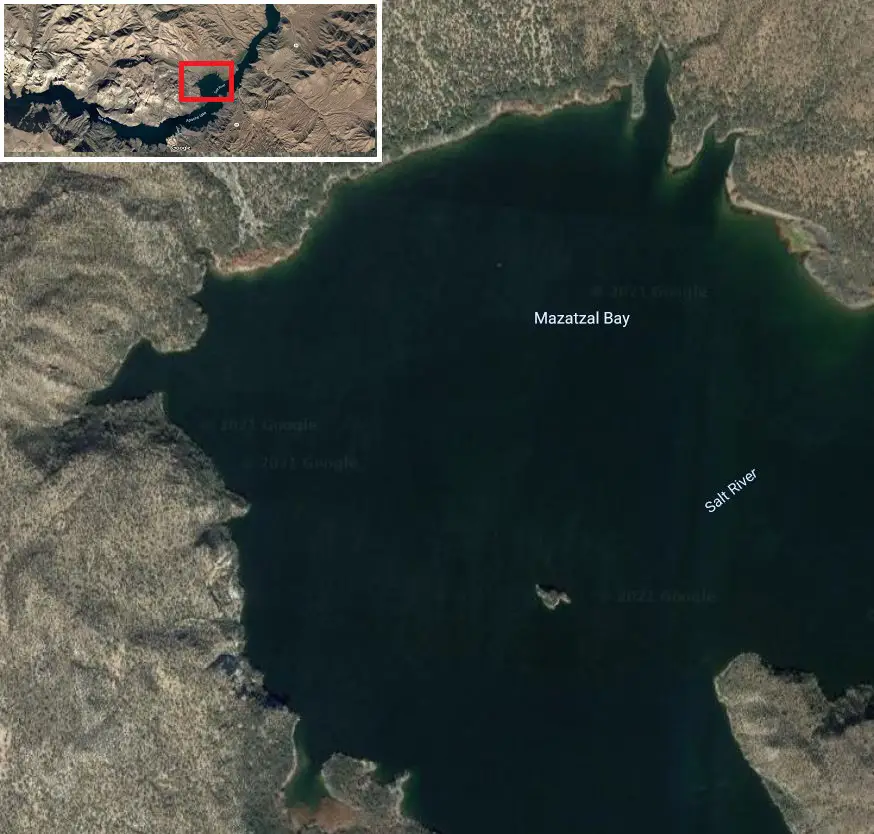
Mazatzal Cove is a great cove to target year-round.
Be sure to graph the cove for multiple submerged humps and submerged brush and timber along the edges.
The western edge of the cove offers mesquite and cottonwood trees that can overhang into the lake when the water is high = perfect bait skipping opportunity.
Effective baits for this area include: topwater lures, buzzbaits, crankbaits, spinnerbaits, umbrella rigs, chatterbaits, jerkbaits, underspin jigs, swim jigs, hair jigs, and soft plastic swimbaits perform well here in breezy conditions.
In contrast, slower moving baits such as drop shot, football jigs, tubes, wacky rig, Texas rig, Neko rigs, and Carolina rigs can be phenomenal when the conditions are calm or the bass are holding close to the rocks.
Located: east end, south side
Structural features: Rocky structure, minimal submerged brush, drop-offs, points.
Best species to target: Bass, yellow bass, crappie, bream
Most effective way to fish this spot: Boat
Small coves between Gila Bay to Chukar Wash
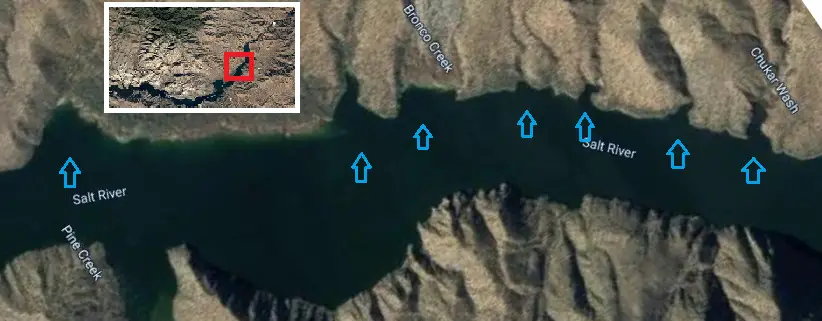
These numerous small coves can be great during for early morning or evening fishing.
Often they have submerged vegetation and even timber.
Effective baits for this area include: topwater lures, buzzbaits, crankbaits, spinnerbaits, umbrella rigs, chatterbaits, jerkbaits, underspin jigs, swim jigs, hair jigs, and soft plastic swimbaits perform well here in breezy conditions.
In contrast, slower moving baits such as drop shot, football jigs, tubes, wacky rig, Texas rig, Neko rigs, and Carolina rigs can be phenomenal when the conditions are calm or the bass are holding close to the rocks.
Located: east end, north side
Structural features: Rocky structure, minimal brush, drop-offs, points
Best species to target: Bass, yellow bass, crappie, bream
Most effective way to fish this spot: Boat
West walls of Horse Flat
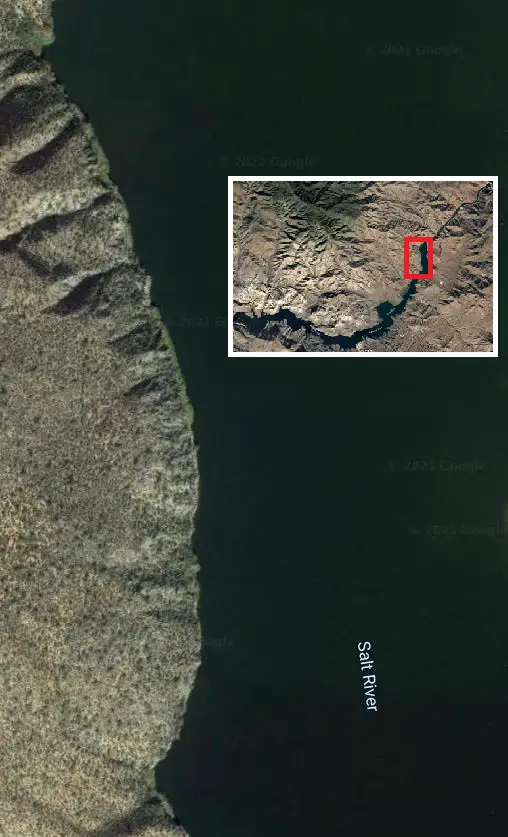
These steep rocky bluff walls are great if you’re wanting to catch bass.
The Horse Flat area really shines in mid to late afternoon because the setting sun will create a great shadow line.
The river channel will often harbor bass, crappie, yellow bass, and catfish that retreat away from the midday heat can be fished in a similar way.
The bass will commonly hold close to the large boulders (especially in the shadows), on the submerged shelves, or located on the bluff wall-to-bank transitions areas. Looks for transition areas that turn from steep rock wall to boulders, then to chunk rock and pea-gravel.
Effective baits for this area include: topwater lures, buzzbaits, crankbaits, soft plastic swimbaits, chatterbaits, spinnerbaits, jerkbaits, swim jigs, hair jigs, and underspin jigs when the bass are aggressive.
If the bass are timid, then drop shot, tubes, wacky rigged senko, Mojo rig, Texas rig, Ned rig, Neko rig, Mojo rig, Carolina rig, and football jigs all work really well.
Located: east end
Structural features: Steep rocky canyon walls, minimal brush, ledges, scattered boulders, and drop-offs
Best species to target: Bass, yellow bass, crappie, bream
Most effective way to fish this spot: Boat or kayak
Bluff walls along the Buckhorn Creek area
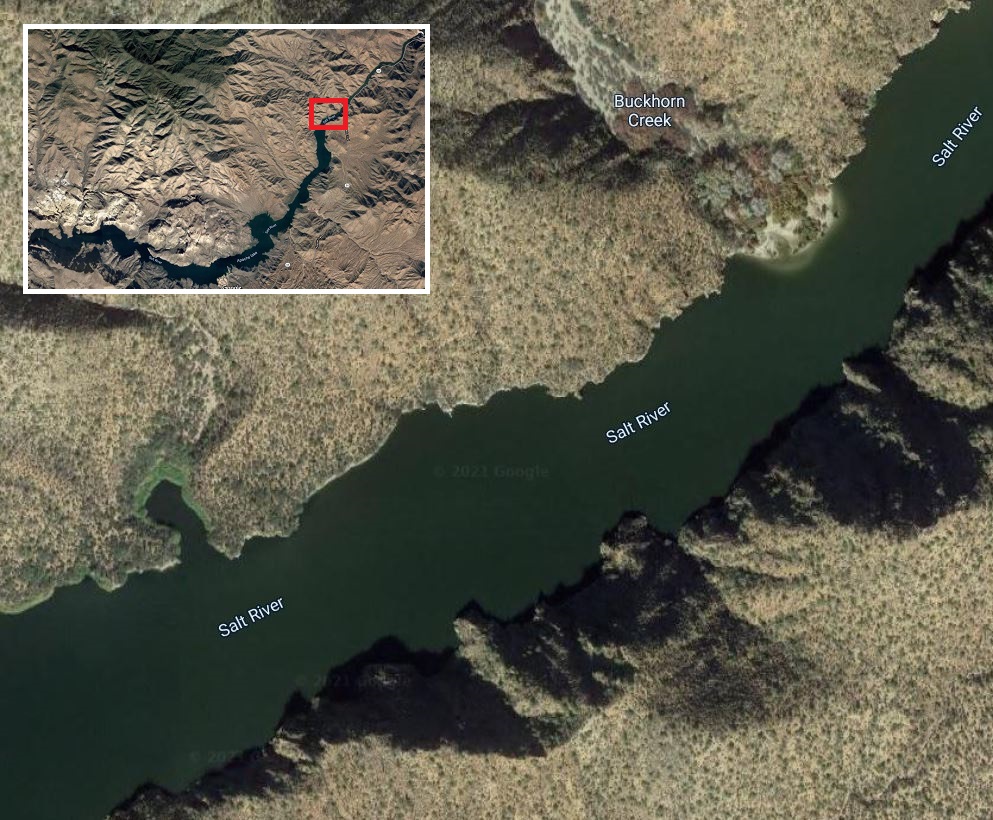
Similar to the bluff walls you’ll see at Horse Flat, these bluff walls are actually on the “south side” of the river.
These steep rocky bluff walls will cast an afternoon shadow starting around noon.
Unfortunately, this area can be very finicky if you’re wanting to catch bass.
This spot is best fished if the weather is warm and the breeze and current is slow.
The river channel will often harbor bass, crappie, yellow bass, and catfish that retreat away from the midday heat can be fished in a similar way.
The bass will commonly hold close to the large boulders (especially in the shadows), on the submerged shelves, or located on the bluff wall-to-bank transitions areas. Looks for transition areas that turn from steep rock wall to boulders, then to chunk rock and pea-gravel.
Effective baits for this area include: topwater lures, buzzbaits, crankbaits, soft plastic swimbaits, chatterbaits, spinnerbaits, jerkbaits, swim jigs, hair jigs, and underspin jigs when the bass are aggressive.
If the bass are timid, then drop shot, tubes, wacky rigged senko, Mojo rig, Texas rig, Ned rig, Neko rig, Mojo rig, Carolina rig, and football jigs all work really well.
Located: east end
Structural features: Steep rocky canyon walls, minimal brush, ledges, scattered boulders, and drop-offs
Best species to target: Bass, yellow bass, crappie, bream
Most effective way to fish this spot: Boat or kayak
How To Catch Fish In Apache Lake
Largemouth Bass Fishing at Apache Lake
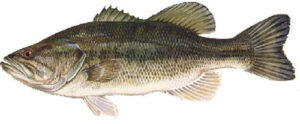 You may be wondering… How do you fish for bass in Apache Lake?
You may be wondering… How do you fish for bass in Apache Lake?
The Largemouth bass is a carnivorous member of the sunfish family. Apache Lake holds the Northern and Florida strain species. The Northern strain is thought to be considered more aggressive and offers a better fight than their Florida strain cousins. Whereas, the Florida strain can grow to an enormous size.
Listed below are a handful of facts, top spots, and best lures to use to help you out…
If you’re still not sure how to catch a bass, do worry. A complete section on Bass Fishing 101 was written to help you out. In that section, you’ll learn about the top ways to get you catching bass fast.
Read more: Beginner’s Guide To Bass Fishing Basics – Tips, Secrets & Things To Avoid
General Largemouth Bass Details
Spawn: Spring, March-May
Food: Shad, bluegill, crayfish
Arizona State Record: 16 lb. 7.68 oz. 28.0 in., Canyon Lake Randall E. White, Mesa 4/22/97
Table Quality: Decent. Firm white meat.
Angling techniques:
Smallmouth Bass Fishing at Apache Lake
 Smallmouth bass are sibling species closely related to largemouth bass. They have a pretty brown/golden color and carry the nickname of “bronzeback”. Some physical features make it different from the largemouth bass. Aside from being bronze in color, they will have grey-brown vertical bands and most definingly is the jaw does not extend past its eye.
Smallmouth bass are sibling species closely related to largemouth bass. They have a pretty brown/golden color and carry the nickname of “bronzeback”. Some physical features make it different from the largemouth bass. Aside from being bronze in color, they will have grey-brown vertical bands and most definingly is the jaw does not extend past its eye.
Overall, smallmouth bass are most likely going about half the size of largemouth bass. However, pound for pound, a smallmouth can be increadably aggressive and will put up an amazing fight.
General Smallmouth Bass Details
Spawn: March-May
Food: fish, crustaceans.
Arizona State Record: 6 lb. 4.48 oz. 21 in. Lake Havasu Sue Nowak, 2/23/17
Table Quality: Similar to a largemouth bass it’s firm, white, flaky, mild-tasting
Angling techniques:
- Finesse jigs
- Mojo Rig
- Neko Rig
- Small crankbaits
- Football Jigs
- Soft plastic swimbaits
- Jerkbaits
- Chatterbaits
- Swim jigs
- Hair jigs
- Underspin jigs
- Drop shot plastic worms
- Tubes
- Streamer flies.
- Live baits: minnows, hellgrammites, and crayfish
Trout Fishing at Apache Lake
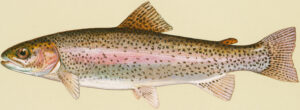 Yes, Apache Lake is stocked with trout.
Yes, Apache Lake is stocked with trout.
Arizona Game & Fish Department grows and stocks local lakes and reservoirs like Apache Lake with Rainbow Trout.
Due to this lake being relatively unpressured, deep, so the stocked trout do very well.
Since the trout are produced in local fisheries, they are healthy and have no limit on the amount of trout that can be consumed.
Typically trout are stocked twice a week, however, it can vary. Click on the highlighted link to find out when.
General Trout Details
Spawn: March-May
Food: insects and crustaceans.
Arizona State Record: 15 lb. 9.12 oz. 32.5 in., Willow Springs Lake Harold Wright, Sun City 9/29/06
Table Quality: Depending on the fishes diet, the meat can be white to orange-red in color. The meat is firm, flaky, and is considered excellent eating.
Angling techniques:
- Trolling with or without downriggers
- Trolling flies
- Worms
- Salmon eggs
- Powerbait
- Corn
- Cheese
- Marshmallows
- Spinners
- Spoons
- Flies
- *The number one key to successful trout fishing, is to use light line (2 to 6 pound) and small hooks (10-14 sizes), and small sinkers
Yellow Bass Fishing at Apache Lake
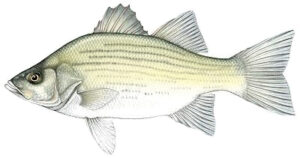 Introduced in 1930 the yellow bass have 4 to 7 dark horizontal lines and are yellow-golden color which is more pronounced over the spine of the fish. They are also a member of the “true bass” family.
Introduced in 1930 the yellow bass have 4 to 7 dark horizontal lines and are yellow-golden color which is more pronounced over the spine of the fish. They are also a member of the “true bass” family.
Ferocious eaters, the yellow bass hunt in schools pursuing schools of threadfin shad. Like some other bass species, yellow bass will also corral the shad near the surface and cause the shad to jump out of the water called a “shad boil”.
This lake has an ample amount of Yellow bass, best of all they’re really easy to catch.
If you are in relatively open water and find a school of shad of your sonar, chances are Yellow bass are close by.
If the Yellow bass bite slows don’t be too quick to find another spot, just back off and scan the area around the shad and find that same school.
Most of the time yellow bass will position and hold closer to any bottom structure more so than the white bass.
If you’re using jigs, spoons or worms, simply flip you bait adjacently or straight through the school of Yellow bass.
Watch your line as it’s falling if it stops mid-fall it means a Yellow bass ate your bait – set the hook!
After you let your bait fall to the bottom raise your rod tip up just a bit. If it feels mushy, it also means a Yellow bass ate your bait – set the hook!
Spawn: March to May
Food: Threadfin shad, other smaller minnows, and fish, insects.
Arizona State Record: 2 lbs. 2.56 oz. 14.25 in., Canyon Lake Ron Johnson, 2/7/20
Table Quality: The meat is excellent. It’s firm, flaky, and white. There is a red lateral line that must be removed otherwise it gives off a strong “fishy” taste. Otherwise, these make excellent fish fry meals.
Angling techniques:
- Spinners
- Spoons
- Small soft plastic swimbaits
- Small lipless crankbaits
- Small topwater poppers and pencil baits
- Hook and worm under a bobber
Black Crappie Fishing at Apache Lake
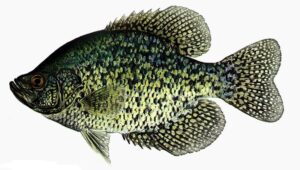 Introduced to Arizona in 1905, Apache Lake holds black crappie. These fish tend to linger over submerged brush and timber and are found in schools.
Introduced to Arizona in 1905, Apache Lake holds black crappie. These fish tend to linger over submerged brush and timber and are found in schools.
The black crappie are much more tolerant in cooler water than their white crappie cousins.
Black crappie can be described as having an irregular black dots and blotched on the back and have more of a “silvery-olive” background.
Average weight of a crappie in Apache Lake is going to be 0.5-0.75-pounds, however electro-netted samples show they can get over 3-pounds in size!
The best time to fish for crappie in this lake and other lakes similar to it is in summertime while you’re night using a submerged green light. If you don’t know what a green fishing light is, or if you’re unfamiliar, then click this link to learn more.
General Crappie Details
Spawn: April – mid-June
Food: Larvae, small fish, and crustaceans. Threadfin shad make up their main diet.
Arizona State Record: 4 lb. 10.0 oz. –in., San Carlos Lake John Shadrick, Mammoth 1959
Table Quality: The meat is excellent. It’s firm, flaky and white.
Angling techniques:
- Live minnows under bobbers
- Crappie jigs
- Crappie tubes
- Silver spoons
- Spinners
Walleye Fishing at Apache Lake
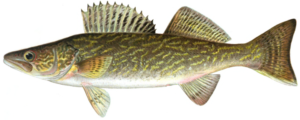 Introduced to Arizona in 1957, Apache Lake holds good size walleye.
Introduced to Arizona in 1957, Apache Lake holds good size walleye.
The average size of a walleye in Arizona will be 1-3-pounds. Some can grow up to 12-pounds and live to nearly 30-years old!
Walleyes have huge eyes which are sensitive to light, so they are usually located near the lake’s bottom, deep channels, and ledges.
These are tasty predators and during the spring spawn they can be found in shallow water, warmer water.
For walleye deep diving crankbaits and inline spinners that imitate baitfish species are a tried and true method.
If you find deep, rocky sections and baitfish nearby, jigging a large spoon will occasionally catch fish as well.
Night fishing for walleyes gives you the best chance to catch one due to their general sensitivity to light.
Make sure to add glass beads above your spinner to make sound, as well as to tip the tip with a juicy nightcrawler with some bait scent for added attraction.
Finally, switch it up to a rattling crankbait if you’re not getting any bites
General Walleye Details
Spawn: March-May
Food: Baitfish, crayfish, and worms. Threadfin shad make up their main diet.
Arizona State Record: 16 lb. 1.76 oz. 31 in., Show Low Lake. Gregg Munck, Show Low 11/18/02
Table Quality: The meat is excellent. It’s firm, flaky and white.
Angling techniques:
- Because of light-sensitive eyes, walleyes feed more actively early in the morning, late in the evening, or at night.
- Trolling or drifting minnows, nightcrawlers, and spinners
- Jointed minnow plugs (silver-black Rapalas)
- Deep diving crankbaits
- Spoons
- Inline spinners
Catfish Fishing at Apache Lake
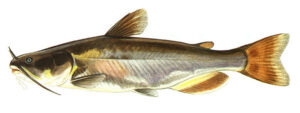
Channel catfish weight will range from 0.5-to-15-pounds in and of the Roosevelt chain lakes, including Apache Lake. However, the average weight will be between 1-4-pounds.
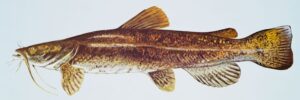
Conversely, “smaller” flathead catfish will weigh in at 15-pounds and can grow around 75-pounds. A flathead survey conducted in 2016 and 2020 caught a flathead that weighed over 48-pounds!
General Catfish Details
Spawn: March-June
Food: Carp, bluegill
Arizona State Record:
Channel catfish – 33 lb., 5.76 oz., 39.5 in., Upper Lake Mary Carson Pete, 3/26/17
Flathead catfish – 76 lb. 8.64 oz., 53.5 in., Bartlett Lake Eddie Wilcoxson, Surprise 04/13/13
Table Quality: Soft white meat. In the summer the meat will taste muddy.
Angling techniques:
Flathead catfish:
- live bait such as smaller carp, full sized bluegill, or tilapia
Channel catfish:
- chicken liver
- hotdogs
- stink bait
- small bluegill
- small carp
Bluegill Fishing at Apache Lake
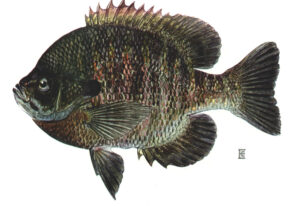 Introduced to Arizona in 1932, the bluegill has teal-blue coloring on the bottom portion of the chin and gill plate. It also has a solid black opercula flap just behind the gill plate.
Introduced to Arizona in 1932, the bluegill has teal-blue coloring on the bottom portion of the chin and gill plate. It also has a solid black opercula flap just behind the gill plate.
Bluegill are found on the shoreline and prefer nearby structures. Bluegill are incredibly aggressive and will quickly attack anything that looks like it could be eaten. Due to their aggressive behavior, they are one of the easiest fish to catch and are a great way to introduce someone to fishing.
Spawn: April and May
Food: Small fish and insects
Arizona State Record: 3 lb. 15.68 oz. 15.75 in., Goldwater Lake. Christopher Ray Mapes, Prescott Valley 5/2/04
Table Quality: Firm, white meat
Angling techniques:
- Worms
- Dough balls
- Slim jim sausages pieces on a small hook (not lying… it really works)
- Small spinners
- Trout flys
Carp Fishing at Apache Lake
Carp are an oily freshwater species of fish and are native to Europe and Asia. Carp are considered invasive to the United States.
The big, hard fighting fish are really fun to catch. Many anglers will fish for carp at night and bowfishing from the shore or from a boat!
Carp can be consumed however, their muddy taste and boney meat make it one of the least desirable fish to eat.
Spawn: March-June
Food: algae, plant matter, fish eggs, insects, aquatic worms, small crustaceans (snails), and small crayfish
Arizona State Record: 37 lb. 0.0 oz. 40.0 in., Bartlett Lake Jonathan Gardner, Phoenix 8/8/87
Table Quality: Poor. Soft white flesh that is muddy and riddled with bones
Angling techniques:
- Dough balls
- Corn
- Worms
- Cherry tomatoes (not kidding)
- Commercial carp baits
Best Species-Specific Fishing Spots at Apache Lake
Top Largemouth Bass Fishing Spots at Apache Lake
- Burnt Rock Cove
- Alder Creek & Amethyst Cove
- Sam’s Straight
- Cross Point
- Haystack Point & Haystack Straight
- Shoreline between Saguaro Point to Horsetail Bay
- Bar Point (Bluff Walls)
- Mazatzal Cove
- Small coves between Gila Bay to Chukar Wash
- West walls of Horse Flat
- Bluff walls along the Buckhorn Creek area
Top Smallmouth Bass Fishing Spots at Apache Lake
- Burnt Rock Cove
- Alder Creek & Amethyst Cove
- Sam’s Straight
- Cross Point
- Haystack Point & Haystack Straight
- Shoreline between Saguaro Point to Horsetail Bay
- Bar Point (Bluff Walls)
- Mazatzal Cove
- Small coves between Gila Bay to Chukar Wash
- West walls of Horse Flat
- Bluff walls along the Buckhorn Creek area
Top Yellow Bass Fishing Spots at Apache Lake
- Burnt Rock Cove
- Alder Creek & Amethyst Cove
- Sam’s Straight
- Cross Point
- Haystack Point & Haystack Straight
- Shoreline between Saguaro Point to Horsetail Bay
- Mazatzal Cove
- Small coves between Gila Bay to Chukar Wash
- Around Apache Marina
Top Trout Fishing Spots at Apache Lake
- Burnt Rock Cove
- Sam’s Straight
- Cross Point
- Graphing deep water near the dam
- Around Apache Marina
Top Crappie Fishing Spots at Apache Lake
- Burnt Rock Cove
- Sam’s Straight
- Cross Point
- Haystack Point & Haystack Straight
- Bar Point (Bluff Walls)
- Small coves between Gila Bay to Chukar Wash
- Bluff walls along the Buckhorn Creek area
Top Catfish Fishing Spots at Apache Lake
- Burnt Rock Cove
- Alder Creek & Amethyst Cove
- Sam’s Straight
- Cross Point
- Haystack Point & Haystack Straight
- Shoreline between Saguaro Point to Horsetail Bay
- Mazatzal Cove
- Small coves between Gila Bay to Chukar Wash
Top Bream/Bluegill Fishing Spots at Apache Lake
- Burnt Rock Cove
- Sam’s Straight
- Cross Point
- Haystack Point & Haystack Straight
- Bar Point (Bluff Walls)
- Small coves between Gila Bay to Chukar Wash
- Bluff walls along the Buckhorn Creek area
Marinas/ Boat Ramps at Apache Lake
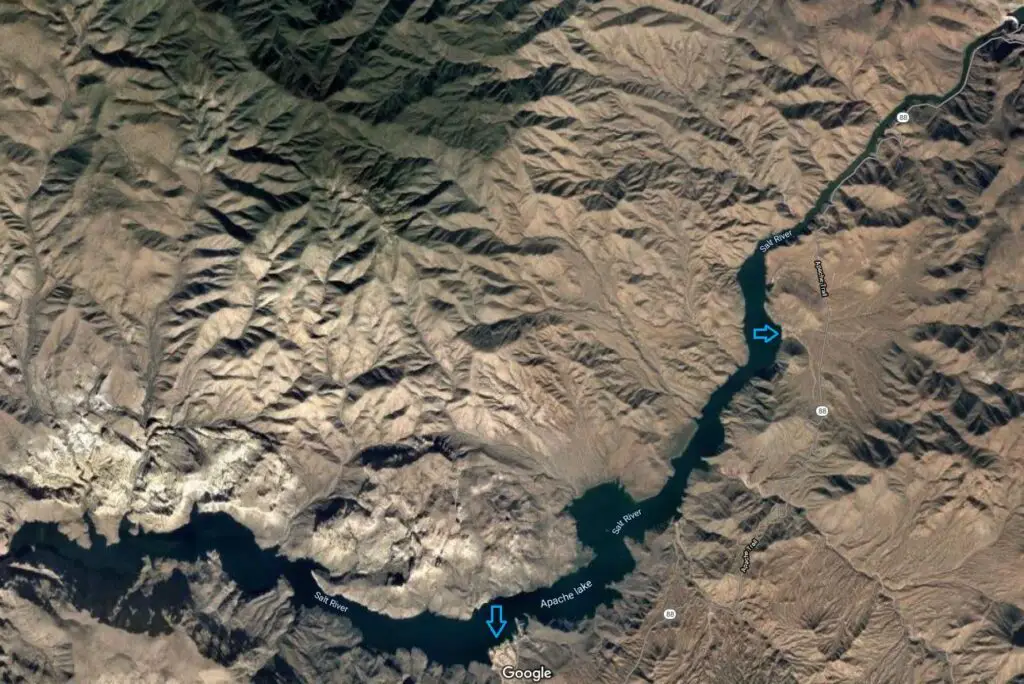
Apache Lake Marina & Boat Ramp
Address: 229.5 Mile Marker, Roosevelt, AZ 85545
Phone number: (928) 467-2511
Groceries/ Snacks: Yes
Bathrooms: Yes
Showers: Yes
Electric: Yes
Gas: Yes
Camping nearby: Yes
Burnt Corral Campgrounds
Address: 3547 AZ-88, Roosevelt, AZ 85545
Phone number: 602-225-5200
Groceries/ Snacks: No
Bathrooms: Yes
Showers: Yes
Electric: Yes
Gas: No
Camping nearby: Yes
Places to camp, lodging and RV parks
Traditional camping areas
- Apache Lake Campground
- Burnt Corral Campground
Lodging
- Yes, Apache Lake Marina & Resort.
Address: 229.5 Mile Marker, Roosevelt, AZ 85545
Phone number: (928) 467-2511
Boat camping areas (primitive)
- Yes
RV Hook-Ups (electric & water)
- Yes, limited
Other Things To Do Near Apache Lake
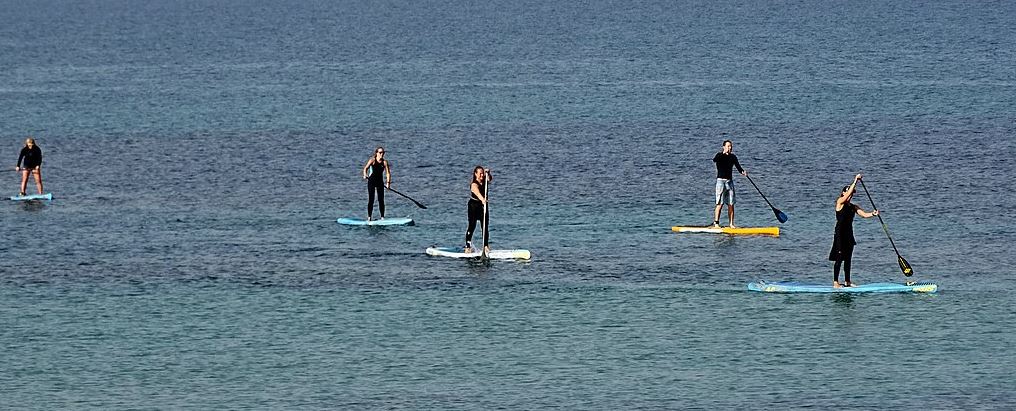
Fishing is not the only thing that brings people to this beautiful body of water. Here’s a list of other things you can do!
- Biking
- Bird watching
- Boating
- Skiing
- Kayaking
- Canoeing
- Paddleboarding
- Sailing
- Swimming
- Camping
- Horseshoes
- Picnicking
- Hiking
- Gentle walking trails
- Nature photography trails
- Wildlife viewing
- Mountain biking
- Stargazing
- and most importantly… relaxing.
Tackle Shops & Tackle Retailers Near Apache Lake
Phoenix Fishing Supply
Located in central Phoenix, Phoenix Fishing Supply has been around since the 1980’s! Even before the big-box stores came into town Phoenix Fishing Supply has been catering to all types of anglers and offers a huge selection of products.
- Address - 4810 North 16th Street, Phoenix, Arizona 85016
- Phone number - (602) 266-2624
- Website - Phoenix Fishing Supply
- Payment methods accepted - Cash, credit, debit
Liar's Korner
Liar’s Korner Fishing Bait & Tackle is nestled in the far east side of metro Phoenix. This tackle shop is proudly run as a small family business that is serious about giving you the right gear to help you catch fish. It doesn’t matter if you’re fishing bass, crappie, walleye, or trout. They have what you need. They carry all the name brands of tackle and gear, and frequently offer better prices than the big-box companies.
- Address - 9529 E Main St, Mesa, AZ 85207
- Phone number - (480) 986-2515
- Website - Liar's Korner facebook page
- Payment methods accepted - Cash, credit, debit
Bass Pro Shops
Located on the east side Phoenix, Bass Pro Shops caters to very type of angler who wants to get their line wet. Founded in 1972 by angler Johnny Morris in Springfield, Missouri Bass Pro Shops combines a massive tackle shop with their hunting, boating, conservation, and guide trips into a comprehensive outdoor and fishing retailer.
- Address - 1133 N Dobson Rd, Mesa, AZ 85201
- Phone number - (602) 606-5600
- Website - Bass Pro Shops
- Payment methods accepted - Cash, credit, debit
Sportsman's Warehouse
Sportsman’s Warehouse feels like a combination of a small outdoor outfitter shop with the capacity to hold a large amount of tackle, gear, and other outdoor accessories. The staff is friendly, patient, and knowledgeable. Sportsman’s Warehouse carries a wide variety of gear for every bass, catfish, trout, crappie, walleye, and pike to get you started.
- Address - 19205 N 27th Ave, Phoenix, AZ 85027
- Phone number - (623) 516-1400
- Website - Sportsman’s Warehouse
- Payment methods accepted - Cash, credit, debit, apple pay
Do you need a Tonto Pass for Apache Lake?
Yes, a Tonto Pass is required if you are going to fish this lake. Luckily there are several types of passes that you can purchase. There are also several different places you can easily purchase a Tonto Pass.
Tonto Pass Options
Tonto Daily Pass – $8
Sold at Tonto National Forest offices, retail outlets and online.
Tonto Daily Passes are hangtags, designed to be self-validating.
Tonto Discovery Pass – $80
Sold at Tonto National Forest Offices only.
The Tonto Discovery Pass is an annual pass valid for one year (expires at the end of the month and year punched on the card) from the time of purchase. The pass must be displayed in the provided hangtag from the rearview mirror. The Tonto Discovery Pass is valid for the pass holder (person(s) who signed the back of the pass) and the occupants of a single, private non-commercial vehicle.
Tonto Senior and Access Pass – $60
Sold at Tonto National Forest Offices only.
Persons ages 62 or older are eligible for the Tonto Discovery Senior pass. The Tonto Senior Discovery and Access Pass are two separate annual passes valid for one year (expiring at the end of the month and year punched on the card) from the time purchased. The pass must be displayed in the provided hangtag from the rearview mirror. The Tonto Discovery Pass is valid for a single pass holder (or person who signed the back of the pass) and the occupants of a single, private non-commercial vehicle. Please call any of our offices listed on the side to see if you qualify for the Senior pass or our Access Pass.
Tonto Discovery Vehicle Sticker: Free
(With purchase of Tonto Discovery Pass)
This pass is meant for OPEN TOP vehicles only where the regular Discovery Pass hangtag cannot be used or can be easily stolen. It is meant to be placed on your front windshield and used as a Tonto Discovery Pass. It is valid for a year from the day you purchase it. Only one sticker will come at request with the purchase of a Tonto Discovery Pass.
Proof of current registration/ownership of your open top vehicle/motorcycle is required at time of issuance to validate and receive the vehicle sticker. Customer must carry their Tonto Pass Hangtag with them when driving a vehicle with a vehicle sticker.
Watercraft Use Sticker – $4
One sticker must be permanently affixed to a Tonto Daily Pass for each motorized watercraft that the vehicle tows or otherwise carries to the lake. “Motorized watercraft’ means any watercraft that is propelled by machinery whether or not the machinery is the principal source of propulsion.
Where Are the Tonto Passes Sold?
There are several ways you can purchases Tonto Passes:
- At the Tonto National Forest supervisor’s and district ranger offices
- At a variety of retail outlets around Arizona and along routes that forest visitors use to reach recreation sites on the Tonto National Forest
- Purchase annual and daily passes online
- By phone or mail Purchase by Phone or Mail
One of the unique features of the Tonto Pass program is the participation of retail outlets, small and large local businesses that sell the pass at many locations throughout the Phoenix metropolitan area, other Arizona cities and towns, and within the Tonto National Forest.
Other Arizona Related Fishing Articles
- Top 20 Best Places To Fish In Arizona 2023
- Interactive AZ Fishing Map 2023 – Where To Go Fishing In Arizona
- How much does a Arizona fishing license cost?
- Best Tackle Shops In Phoenix Arizona 2023
- Best Bass Fishing Lakes in Arizona 2023 (Voted by Local Anglers!)
- Alamo Lake Fishing Report 2025
- Apache Lake Fishing Report 2025
- Ashurst Lake Fishing Report 2025
- Bartlett Lake Fishing Report 2025
- Bear Canyon Lake Fishing Report 2025
- Big Lake Fishing Report 2025
- Blue Ridge Reservoir Fishing Report 2025
- Canyon Lake Fishing Report 2025
- Chevelon Lake Fishing Report 2025
- Kinnikinick Lake Fishing Report 2025
- Lake Havasu Fishing Report 2025
- Lake Mary Fishing Report 2025
- Lake Pleasant Fishing Report 2025
- Patagonia Lake Fishing Report 2025
- Rainbow Lake Fishing Report 2025
- Roosevelt Lake Fishing Report 2025
- Saguaro Lake Fishing Report 2025
- Show Low Lake Fishing Report 2025
- Sunrise Lake Fishing Report 2025
- Willow Springs Lake Fishing Report 2025
- Woods Canyon Lake Fishing Report 2025
More articles just for you...
Funny Fishing Rules, Laws, and Regulations 2025
Crazy Fishing Laws That Will Blow Your Mind! #7 is INSANE! Strange Fishing Regulations and Laws As silly as hook and rod limits may seem,
EXPOSED! How To Use A Spinnerbait The Right Way for 2025
Are You Wondering How To Use A Spinnerbait? Or How To Work A Spinnerbait Over Grass, Logs, or Points? Well, All These Questions Are Answered
EXPOSED! Best Crankbait Colors for 2025 [Which to Buy & Avoid]
What color crankbait to use? Crankbait Color Chart I just love going into a Bass Pro Shops store and just staring at all the walls
Best Underwater Dock Lights For Fishing – 2025 Buyers Guide
Night Dock Light Fishing For Beginners Dear fellow angler, Does this sound like you? You’re someone who loves fishing but just wants to escape the
15 Best Deep Diving Crankbaits [2025 Buyers Guide – Which to Buy & Avoid]
A Complete Buyer’s Blueprint On The Best Deep Diving Crankbaits for Bass, Walleye, or Striped Bass On The Market Today Fishing deep diving crankbaits can

